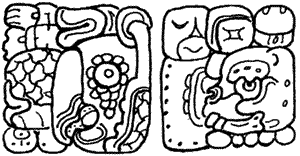
K'INICH AHKAL MO' NAHB' III
A New Reading of the Glyphs
by David Stuart
![]()
|
The protagonist of Temple XIX is the ruler K'inich Ahkal Mo' Nahb', who in previous studies of Palenque's history has had several names or nicknames.
Heinrich Berlin (1967), in his study of the Tablet of the 96 Glyphs, referred to him as Subject C. Shortly thereafter, Mathews and Schele (1974) used the name "Lord Chaac" (and later "Chaacal") for this king, placing him in a more detailed historical context. Subsequent studies revealed that two Early Classic Palenque rulers took the same name (sans the K'inich honorific prefix), resulting in a threesome of Palencano rulers known as "Chaacal I," "Chaacal II," and "Chaacal III," the last being the Late Classic associated with Temple XIX. To complicate matters somewhat, another name for these kings, "Akul Anab," has been proposed, seeking a more accurate account of the name glyph's constituent elements. With my new revision presented here, a few explanatory comments are warranted. The name has three essential components, each of which may have a few variants: Customarily the signs 'a-ku-la, which can be replaced by a turtle's head 'AHK and -la, or, as in the newer examples, a turtle carapace 'AHK followed by -la. There can be little doubt here that the turtle signs are logograms replacing the syllabic spelling for 'ahk, "turtle," as shown in several other royal names of the Classic period. The dysharmonic spelling 'a-ku is perhaps used to indicate the unusual nature of the internal vowel of the root 'ahk (Houston, Robertson and Stuart 1998). In the Palenque name, the presence of the -la suffix probably points to the pronunciation 'ahk-al, rather than 'ahk-ul, since the ku syllable is intrinsic to the "turtle" root. We can therefore transcribe this portion of the name more accurately as 'AHK-AL, with the -la sign "reversed" to represent one of the common -Vl derivational suffixes. In the majority of examples of this name the next sign represents a parrot's beak, shown sometimes as a suffix to 'AHK-AL. A parrot's beak is otherwise a very familiar sign with the value 'a, as found in numerous spellings of 'a-ku already described. This form emphasizes the elongated and hooked upper beak of a parrot, which we know to have been used as an 'a form in texts from the end of the Late Classic period. However, for several years I have been intrigued by the consistency of this hooked variant in a name where the more conventional beak form of 'a (T229) is so common. The two beaks, that is, seem to be distinguished visually, at least in this context. Interestingly, in the inscriptions of Copan, the hooked beak sign is used as a short-hand form of MO', "macaw," as in the place name Mo' Wits, "Macaw Mountain.' I had considered that perhaps MO' was the true reading of this beak in the Palenque name, yet confirmation did not appear until the discovery of the Temple XIX texts, where an obvious macaw's head appears as a fuller version of the beak. We can therefore read 'Ahkal Mo' as the first two parts of the name. Lastly we find in this name the common grouping na-b'i, usually directly after the macaw's beak. This is known to be replaced in other contexts by a logogram read NAHB', for "pool, lake." The logographic forms of NAHB' all emphasize the water lily image, usually as part of a larger "spotted winal" form, the superfixed blossom of which can alone serve as NAHB' (and always read in final position). In the Temple XIX examples of the name which exhibit the turtle shell we find the macaw head draped by tendrils of a water lily pad, providing a more "iconographic" image of the sign. Taken as a whole, then, we have the resulting name 'Ahkal Mo' Nahb', which I now take to be an accurate reading of the glyphic components. The Late Classic king who was the third to take this name added the honorific prefix K'INICH to this base, giving us the full form K'inich 'Ahkal Mo' Nahb'. |
Drawing by Merle Greene Robertson.